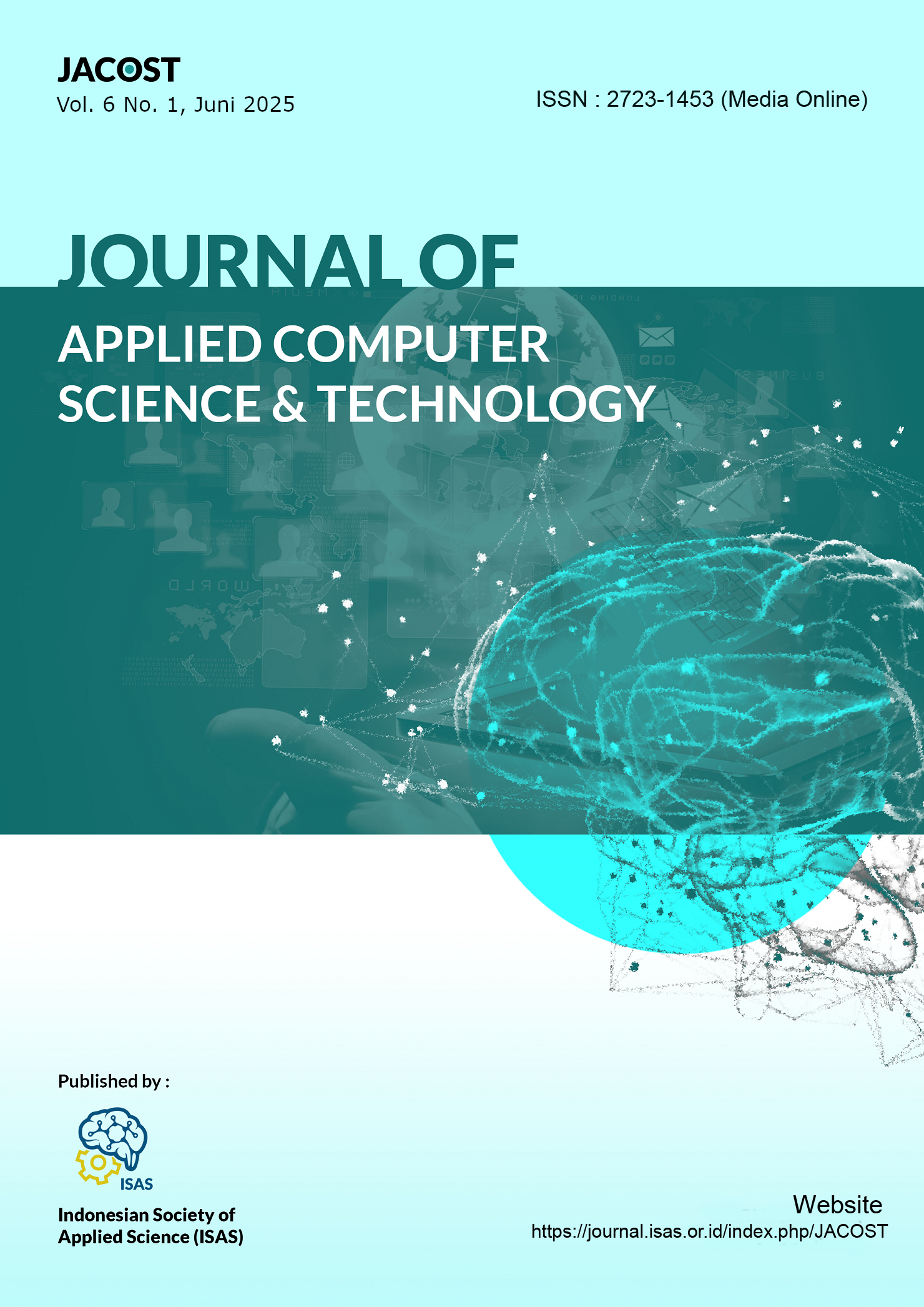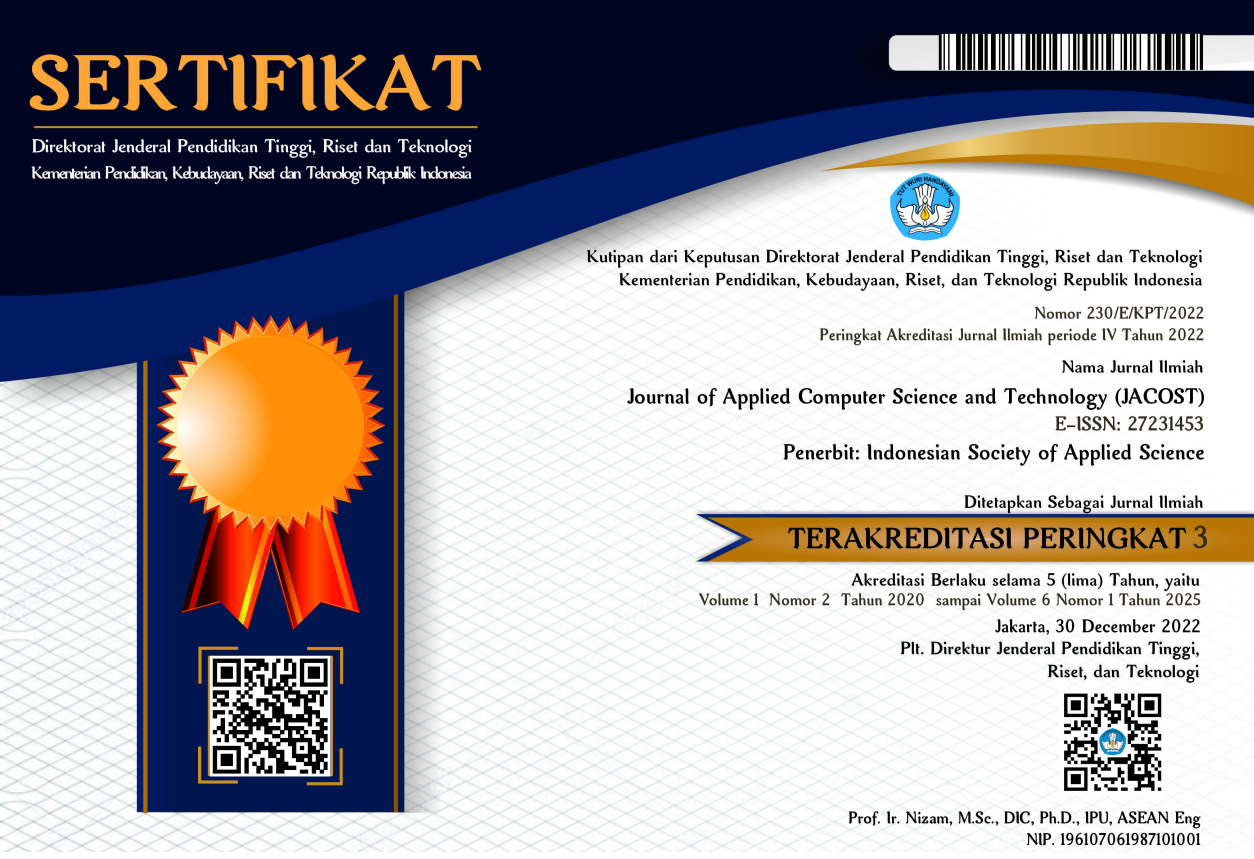Penentuan Faktor Pemicu Gejala Penyakit Mata Glaukoma, Astigmatis, Hipermetropi, dan Miopi
DOI:
https://doi.org/10.52158/jacost.v6i1.1113Keywords:
Backward Chainig, Simple Additive Weighting, Eye DeseaseAbstract
Expert systems support medical problem-solving, including the analysis of eye diseases. According to BPS RI (2022), over 8 million Indonesians suffer from visual impairments. In diagnosis, doctors often struggle to identify the primary causes of symptoms, impacting treatment effectiveness. This study proposes a system that combines Backward Chaining and Simple Additive Weighting (SAW) to systematically identify and prioritize causal factors of eye diseases. Backward Chaining is used to trace relationships between symptoms and the causes of glaucoma, astigmatism, hyperopia, and myopia. SAW is applied to assign weights to each causal factor and determine priority based on score ranking. Testing with 45 patient cases shows the system achieves 91% accuracy in identifying dominant causes. The 9% error rate stems from data limitations, subjective weighting in SAW, and inference rules in Backward Chaining. This system offers valuable support in early decision-making by helping doctors prioritize handling strategies based on the most significant underlying factors, thereby enhancing diagnostic efficiency and consistency.
Downloads
References
D. G. H. Divayana, P. W. A. Suyasa, and A. Adiarta, “Improvement of experts’ weights based on Tat Twam Asi in the TOPSIS method as a supporting parameter for optimization of blended learning evaluation results,” in AIP Conference Proceedings, 2023. doi: 10.1063/5.0106205.
I. P. A. Sanjaya, I. G. A. Gunadi, and G. Indrawan, “Expert System Using Certainty Factor Method For Adjustment Of Learning Styles With Students,” J. Comput. Networks, Archit. High Perform. Comput., 2023, doi: 10.47709/cnahpc.v5i1.2068.
X. Wang et al., “Automatic Detection of 30 Fundus Diseases Using Ultra-Widefield Fluorescein Angiography with Deep Experts Aggregation,” Ophthalmol. Ther., 2024, doi: 10.1007/s40123-024-00900-7.
Q. Chen, T. Leng, S. Niu, and E. Trucco, “Editorial: Generalizable and explainable artificial intelligence methods for retinal disease analysis: challenges and future trends,” Front. Med., vol. 11, 2024, doi: 10.3389/fmed.2024.1465369.
I. P. W. Ariawan, D. G. H. Divayana, and M. K. W. Giri, “Usage tests of the CIPP model evaluation application integrated with the SAW method to evaluate the effectiveness of the e-learning implementation,” in AIP Conference Proceedings, 2023. doi: 10.1063/5.0106279.
N. K. Y. Suartini, D. G. H. Divayana, and L. J. E. Dewi, “Comparison Analysis of AHP-SAW, AHP-WP, AHP-TOPSIS Methods in Private Tutor Selection,” Int. J. Mod. Educ. Comput. Sci., vol. 15, no. 1, pp. 28–45, 2023, doi: 10.5815/ijmecs.2023.01.03.
R. N. Ramdhani and H. Haryati, “The Simple Additive Weighting (SAW) Method To Determine the Recipient of the Patient Assistance Fund,” J. Inov. Ilmu Komput., vol. 1, no. 1, pp. 68–78, 2022, [Online]. Available: http://ejurnal-wit.ac.id/index.php/JIIK/article/view/96%0Ahttp://ejurnal-wit.ac.id/index.php/JIIK/article/download/96/87
N. Vafaei, R. A. Ribeiro, and L. M. Camarinha-Matos, “Assessing Normalization Techniques for Simple Additive Weighting Method,” in Procedia Computer Science, 2021. doi: 10.1016/j.procs.2022.01.156.
R. P. Adhitama, D. R. S. Saputro, and S. Sutanto, “Hill Climbing Algorithm on Bayesian Network to Determine Probability Value of Symptoms and Eye Disease,” BAREKENG J. Ilmu Mat. dan Terap., 2022, doi: 10.30598/barekengvol16iss4pp1271-1282.
M. I. R. Ihsan, L. A. Fitriana, R. Dahlia, and A. Fachrurozi, “Sistem Pakar Diagnosa Penyakit pada Gigi Berbasis Web dengan Penalaran Forward Chaining,” J. Ilm. Elektron. dan Komput., vol. 15, no. 2, pp. 403–411, 2022, doi: https://doi.org/10.51903/elkom.v15i2.921.
R. Stefani, “Sistem Pakar Diagnose Penyakit pada Ikan Koi menggunakan Metode Backward Chaining,” J. Ris. Rumpun Ilmu Hewani, vol. 1, no. 2, pp. 16–30, 2022, doi: https://doi.org/10.55606/jurrih.v1i2.526.
Kemenkes RI, Peta Jalan Penanggulangan gangguan penglihatan di Indonesia Tahun 2017-2030. 2019. [Online]. Available: http://www.p2ptm.kemkes.go.id/dokumen-ptm/buku-peta-jalan-penanggulangan-gangguan-penglihatan-di-indonesia-tahun-2017-2030
R. S. Douglas, A. N. McCoy, and S. Gupta, Thyroid eye disease, 1st ed. Springer New York, 2015. [Online]. Available: https://www.google.co.id/books/edition/Gangguang_dan_Kesehatan_Mata/I1AdDQAAQBAJ?hl=id&gbpv=0
T. Makoni, G. Kadziyanhike, C. Mademutsa, M. Mlambo, and K. Malama, “Community-led monitoring: a voice for key populations in Zimbabwe,” J. Int. AIDS Soc., 2022, doi: 10.1002/jia2.25925.
A. Santone, M. Cesarelli, E. Colasuonno, V. Bevilacqua, and F. Mercaldo, “A Method for Ocular Disease Diagnosis through Visual Prediction Explainability,” Electron., vol. 13, no. 14, pp. 1–33, 2024, doi: 10.3390/electronics13142706.
A. W. O. Gama, I. W. Sukadana, and G. H. Prathama, “Sistem Pakar Diagnosa Awal Penyakit Mata (Penelusuran Gejala dengan Metode Backward Chaining),” J-Eltrik, vol. 1, no. 2, p. 34, 2021, doi: 10.30649/j-eltrik.v1i2.34.
U. Humayrah, A. T. Sumpala, Y. P. Pasrun, and S. Bantun, “Sistem Pakar Diagnosis Penyakit Mata Menggunakan Certainty Factor Berbasis Web,” Pros. Semin. Nas. Pemanfaat. Sains dan Teknol. Inf., vol. 1, no. 1, pp. 439–448, 2023, [Online]. Available: https://epublikasi.digitallinnovation.com/index.php/sempatin/article/view/84
D. N. Yoliadi, “Implementation of the breadth-first search method on forward-chaining inferences to diagnose autism disorders in children,” J. Tek. Inform. C.I.T Medicom, vol. 15, no. 2, pp. 58–72, 2023, doi: 10.35335/cit.vol15.2023.339.pp58-72.
A. R. Jari and M. F. Asnawi, “Rancang Bangun Sistem Pakar Diagnosa Penyakit Pada Buah Salak Berbasis Web Menggunakan Algoritma Backward Chaining,” STORAGE J. Ilm. Tek. dan Ilmu Komput., vol. 2, no. 1, pp. 15–19, 2023, doi: 10.55123/storage.v2i1.1719.
M. R. Ahmed, S. R. Ahmed, A. D. Duru, O. N. Ucan, and B. Oğuz, “An Expert System to Predict Eye Disorder Using Deep Convolutional Neural Network,” Acad. Platf. J. Eng. Sci., vol. 9, no. 1, pp. 47–52, 2021, doi: 10.21541/apjes.741194.
N. Muliyana, S. Hendra, H. R. Ngemba, Alamsyah, and M. A. Indrajaya, “Expert System for Diagnosing Diseases in Cats Using the Forward Chaining Method,” Jatilima, vol. 5, no. 11, pp. 10–14, 2023.
Downloads
Published
Issue
Section
License
Pernyataan Hak Cipta dan Lisensi
Dengan mengirimkan manuskrip ke Journal of Applied Computer Science and Technology (JACOST), penulis setuju dengan kebijakan ini. Tidak diperlukan persetujuan dokumen khusus.
- Hak cipta pada setiap artikel adalah milik penulis.
- Penulis mempertahankan semua hak mereka atas karya yang diterbitkan, tak terbatas pada hak-hak yang diatur dalam laman ini.
- Penulis mengakui bahwa Journal of Applied Computer Science and Technology (JACOST) sebagai yang pertama kali mempublikasikan dengan lisensi Creative Commons Atribusi 4.0 Internasional (CC BY-SA).
- Penulis dapat memasukan tulisan secara terpisah, mengatur distribusi non-ekskulif dari naskah yang telah terbit di jurnal ini kedalam versi yang lain (misal: dikirim ke respository institusi penulis, publikasi kedalam buku, dll), dengan mengakui bahwa naskah telah terbit pertama kali pada Journal of Applied Computer Science and Technology (JACOST);
- Penulis menjamin bahwa artikel asli, ditulis oleh penulis yang disebutkan, belum pernah dipublikasikan sebelumnya, tidak mengandung pernyataan yang melanggar hukum, tidak melanggar hak orang lain, tunduk pada hak cipta yang secara eksklusif dipegang oleh penulis.
- Jika artikel dipersiapkan bersama oleh lebih dari satu penulis, setiap penulis yang mengirimkan naskah menjamin bahwa dia telah diberi wewenang oleh semua penulis bersama untuk menyetujui hak cipta dan pemberitahuan lisensi (perjanjian) atas nama mereka, dan setuju untuk memberi tahu rekan penulis persyaratan kebijakan ini. Journal of Applied Computer Science and Technology (JACOST) tidak akan dimintai pertanggungjawaban atas apa pun yang mungkin timbul karena perselisihan internal penulis.
Lisensi :
Journal of Applied Computer Science and Technology (JACOST) diterbitkan berdasarkan ketentuan Lisensi Creative Commons Atribusi 4.0 Internasional (CC BY-SA). Lisensi ini mengizinkan setiap orang untuk :.
- Berbagi — menyalin dan menyebarluaskan kembali materi ini dalam bentuk atau format apapun;
- Adaptasi — menggubah, mengubah, dan membuat turunan dari materi ini untuk kepentingan apapun.
Lisensi :
-
Atribusi — Anda harus mencantumkan nama yang sesuai, mencantumkan tautan terhadap lisensi, dan menyatakan bahwa telah ada perubahan yang dilakukan. Anda dapat melakukan hal ini dengan cara yang sesuai, namun tidak mengisyaratkan bahwa pemberi lisensi mendukung Anda atau penggunaan Anda.
-
BerbagiSerupa — Apabila Anda menggubah, mengubah, atau membuat turunan dari materi ini, Anda harus menyebarluaskan kontribusi Anda di bawah lisensi yang sama dengan materi asli.

















